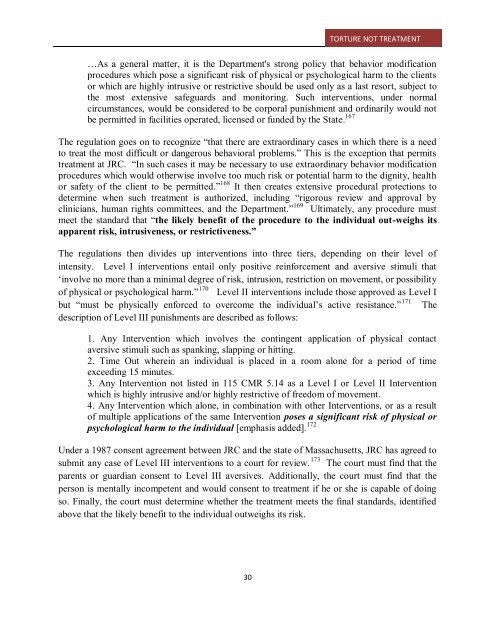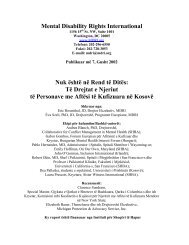Torture not Treatment - Disability Rights International
Torture not Treatment - Disability Rights International
Torture not Treatment - Disability Rights International
Create successful ePaper yourself
Turn your PDF publications into a flip-book with our unique Google optimized e-Paper software.
TORTURE NOT TREATMENT<br />
…As a general matter, it is the Department's strong policy that behavior modification<br />
procedures which pose a significant risk of physical or psychological harm to the clients<br />
or which are highly intrusive or restrictive should be used only as a last resort, subject to<br />
the most extensive safeguards and monitoring. Such interventions, under normal<br />
circumstances, would be considered to be corporal punishment and ordinarily would <strong>not</strong><br />
be permitted in facilities operated, licensed or funded by the State. 167<br />
The regulation goes on to recognize ―that there are extraordinary cases in which there is a need<br />
to treat the most difficult or dangerous behavioral problems.‖ This is the exception that permits<br />
treatment at JRC. ―In such cases it may be necessary to use extraordinary behavior modification<br />
procedures which would otherwise involve too much risk or potential harm to the dignity, health<br />
or safety of the client to be permitted.‖ 168 It then creates extensive procedural protections to<br />
determine when such treatment is authorized, including ―rigorous review and approval by<br />
clinicians, human rights committees, and the Department.‖ 169 Ultimately, any procedure must<br />
meet the standard that ―the likely benefit of the procedure to the individual out-weighs its<br />
apparent risk, intrusiveness, or restrictiveness.‖<br />
The regulations then divides up interventions into three tiers, depending on their level of<br />
intensity. Level I interventions entail only positive reinforcement and aversive stimuli that<br />
‗involve no more than a minimal degree of risk, intrusion, restriction on movement, or possibility<br />
of physical or psychological harm.‖ 170 Level II interventions include those approved as Level I<br />
but ―must be physically enforced to overcome the individual‘s active resistance.‖ 171 The<br />
description of Level III punishments are described as follows:<br />
1. Any Intervention which involves the contingent application of physical contact<br />
aversive stimuli such as spanking, slapping or hitting.<br />
2. Time Out wherein an individual is placed in a room alone for a period of time<br />
exceeding 15 minutes.<br />
3. Any Intervention <strong>not</strong> listed in 115 CMR 5.14 as a Level I or Level II Intervention<br />
which is highly intrusive and/or highly restrictive of freedom of movement.<br />
4. Any Intervention which alone, in combination with other Interventions, or as a result<br />
of multiple applications of the same Intervention poses a significant risk of physical or<br />
psychological harm to the individual [emphasis added]. 172<br />
Under a 1987 consent agreement between JRC and the state of Massachusetts, JRC has agreed to<br />
submit any case of Level III interventions to a court for review. 173 The court must find that the<br />
parents or guardian consent to Level III aversives. Additionally, the court must find that the<br />
person is mentally incompetent and would consent to treatment if he or she is capable of doing<br />
so. Finally, the court must determine whether the treatment meets the final standards, identified<br />
above that the likely benefit to the individual outweighs its risk.<br />
30




